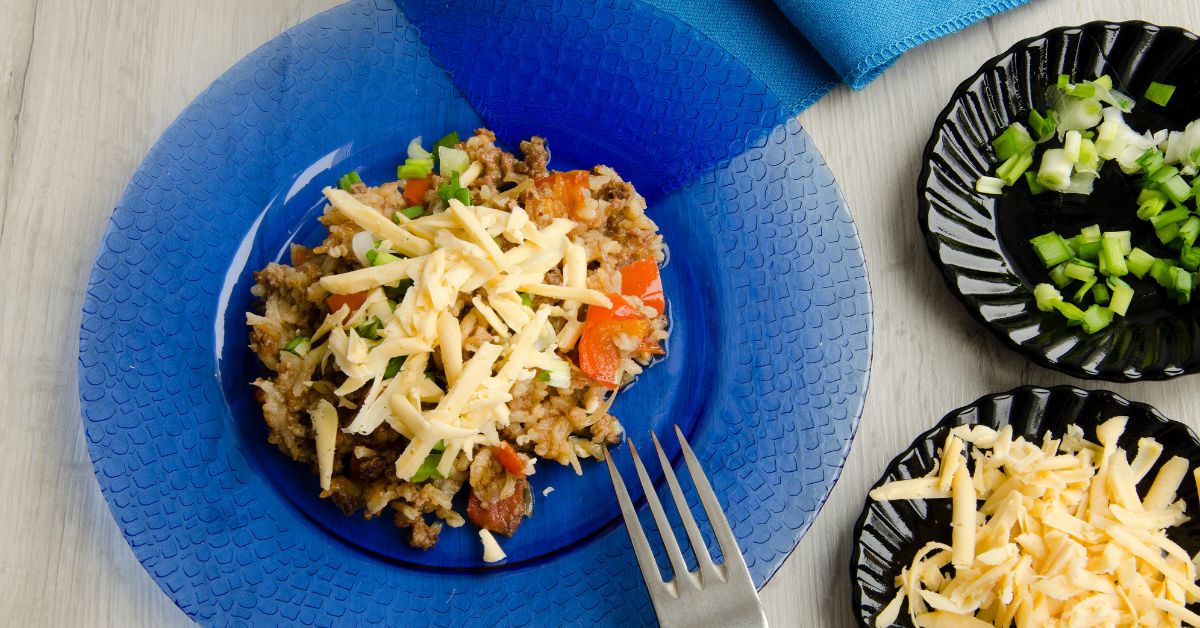Texas Hash – a name that resonates with the warmth of southern comfort food, a dish steeped in tradition and bursting with flavors that speak of its rich culinary heritage. Originating from the heart of Texas, this hearty meal has woven its way into the fabric of American regional cuisine, becoming a beloved staple in households across the Lone Star State and beyond.
As we delve deeper into the world of Texas Hash, we uncover not just a recipe, but a story – a story of a dish that has adapted, evolved, and yet remained a comforting presence in Texan kitchens, a dish that continues to bring families together around the dinner table.
What is Texas Hash?
At its core, Texas Hash is a quintessential comfort food, known for its robust flavors and simple preparation. It’s a one-pot wonder that combines the heartiness of ground beef with the wholesomeness of rice, simmered together with a medley of tomatoes, bell peppers, onions, and a rich blend of spices. This dish is not just a meal; it’s a celebration of simplicity and flavor, embodying the spirit of Texan cuisine.
Definition and Key Ingredients
- Ground Beef: The cornerstone of Texas Hash, providing a rich and meaty base.
- Rice: Adds substance and absorbs the flavors of the dish.
- Tomatoes: Canned or fresh, they bring a tangy sweetness and a saucy texture.
- Bell Peppers and Onions: These vegetables add a crunch and a layer of depth to the flavor profile.
- Chili Powder: A key spice that gives Texas Hash its distinctive Texan kick.
- Garlic and Other Spices: Often included to enhance the overall taste.
Variations Across Regions
- Spicier Versions: In some areas, jalapeños or cayenne pepper are added for extra heat.
- Vegetarian Adaptations: Meat is sometimes replaced with beans or lentils in vegetarian versions.
- Rice Substitutes: Quinoa or cauliflower rice can be used for a healthier twist.
- Cheese Topping: In certain regions, a layer of grated cheese is melted over the top before serving.
Each variation of Texas Hash, while staying true to its roots, reflects the local palate and available ingredients, making it a versatile dish that caters to a variety of tastes and preferences. Whether it’s spiced up with extra chili or tweaked to fit dietary needs, Texas Hash remains a beloved dish across Texas and beyond, adaptable yet consistently comforting.
Traditional Texas Hash Recipe
Embark on a culinary journey to the heart of Texas with this traditional Texas Hash recipe. Known for its hearty flavors and simple preparation, this dish is a staple in Texan cuisine, perfect for a family dinner or a cozy night in.
Ingredients List
- 1 pound ground beef
- 1 large onion, diced
- 1 green bell pepper, diced
- 2 cups canned tomatoes, with juice
- 1 cup uncooked long-grain rice
- 2 tablespoons chili powder
- 1 teaspoon garlic powder
- Salt and pepper, to taste
- 2 cups water or beef broth
- Optional: Shredded cheese for topping
Step-by-Step Cooking Instructions
- Brown the Beef: In a large skillet, cook the ground beef over medium heat until it’s no longer pink. Drain excess fat.
- Sauté Vegetables: Add the diced onion and bell pepper to the skillet. Cook until they are soft and the onions are translucent.
- Add Tomatoes and Spices: Stir in the canned tomatoes (with their juice), chili powder, garlic powder, salt, and pepper. Mix well.
- Incorporate Rice: Sprinkle the uncooked rice evenly over the mixture. Do not stir.
- Simmer: Pour in water or beef broth. Bring the mixture to a boil, then reduce heat to low. Cover and simmer for 20-25 minutes, or until the rice is tender.
- Final Touches: If desired, top with shredded cheese. Cover the skillet for a few minutes to let the cheese melt.
- Serve: Enjoy your Texas Hash hot, garnished with fresh herbs if desired.
Tips for the Perfect Texas Hash
- Quality of Ingredients: Use fresh vegetables and high-quality ground beef for the best flavor.
- Rice Cooking: Ensure the rice is evenly spread and submerged in the liquid for even cooking.
- Adjusting Spices: Feel free to adjust the amount of chili powder to suit your heat preference.
- Broth vs. Water: Using beef broth instead of water can add more depth to the flavor.
- Resting Time: Let the dish rest for a few minutes after cooking for the flavors to meld together.
- Leftovers: Texas Hash tastes even better the next day, making it perfect for leftovers.
This traditional Texas Hash recipe is not just a dish; it’s a warm, comforting embrace from the South, bringing the rich flavors of Texan cuisine right to your table.
Nutritional Information
Understanding the nutritional profile of Texas Hash is essential, especially for those mindful of their dietary intake. This classic dish, while hearty and flavorful, can be adapted to meet various nutritional and dietary needs.
Breakdown of Calories, Macros, and Micronutrients
- Calories: A standard serving of Texas Hash typically contains about 350-400 calories, making it a substantial meal option.
- Macronutrients:
- Proteins: The ground beef in Texas Hash is a good source of protein, with each serving providing approximately 20-25 grams.
- Carbohydrates: Primarily from rice, a serving contains around 30-35 grams of carbohydrates.
- Fats: The dish contains about 15-20 grams of fat, largely depending on the leanness of the beef used.
- Micronutrients:
- Vitamins: Bell peppers and tomatoes contribute Vitamin C and A, while onions offer a range of B-vitamins.
- Minerals: Beef is a source of iron and zinc, essential for various bodily functions.
Dietary Considerations
- Gluten-Free Options: Texas Hash is naturally gluten-free, as it primarily consists of meat, vegetables, and rice. However, always check the labels of canned products and spices for any hidden gluten.
- Dairy-Free Recipe: The basic recipe for Texas Hash is dairy-free. If cheese is used as a topping, those with dairy sensitivities can omit it or use a dairy-free cheese alternative.
- Lowering Calories and Fats:
- Use lean ground beef or ground turkey to reduce fat content.
- Increase the proportion of vegetables to reduce overall calorie density.
- Vegetarian and Vegan Adaptations:
- Substitute ground beef with plant-based meat alternatives or increase the quantity of beans for protein.
- Use vegetable broth instead of beef broth.
By understanding the nutritional content and being aware of the various adaptations, Texas Hash can be a versatile dish that fits into many dietary plans, from gluten-free to vegan diets. This adaptability makes it a beloved dish for a wide audience, catering to different health and nutritional needs.
Cooking Techniques and Tips
Mastering the art of cooking Texas Hash is about embracing simplicity while paying attention to detail. Here are some best practices and common pitfalls to avoid, ensuring your Texas Hash is as delightful and flavorful as it can be.
Best Practices for Cooking Texas Hash
- Quality of Ingredients: Start with fresh, high-quality ingredients. Fresh vegetables and good-quality ground beef make a significant difference in flavor.
- Proper Browning of Meat: Ensure the ground beef is well-browned. This step is crucial for developing depth of flavor. Don’t rush it; let the meat develop a nice, rich color.
- Sautéing Vegetables: Cook the onions and peppers until they are soft and the onions are translucent. This enhances their sweetness and blends their flavors more harmoniously with the beef.
- Balancing Spices: Be mindful of the chili powder and other spices. Start with a moderate amount and adjust according to taste. Remember, you can always add more, but you can’t take it away.
- Rice Cooking: Ensure the rice is evenly spread in the skillet and submerged in the liquid for even cooking. Avoid stirring too much once the rice is added, as this can make it mushy.
- Simmering: Allow the dish to simmer gently. This slow cooking process helps the flavors meld together and ensures the rice cooks perfectly.
- Resting Time: Let the dish rest for a few minutes off the heat before serving. This allows the flavors to settle and the rice to absorb any remaining liquid.
Common Mistakes to Avoid
- Overcrowding the Pan: Don’t overcrowd the skillet when browning the meat. This can lead to steaming rather than browning, affecting flavor development.
- Underseasoning: Season the dish well, especially with salt and pepper. Underseasoning can leave it tasting bland.
- Overcooking the Rice: Keep an eye on the rice as it cooks. Overcooking can result in a mushy texture.
- Skipping the Resting Time: Allowing the dish to rest is crucial for the flavors to meld and the rice to finish absorbing the liquid.
- Not Tasting as You Go: Taste and adjust seasonings as you cook. This ensures a well-balanced final dish.
By following these techniques and avoiding common errors, you can create a Texas Hash that’s not only satisfying and hearty but also brimming with the rich, comforting flavors that make this dish a beloved classic.
Variations of Texas Hash
Texas Hash, a versatile and beloved dish, lends itself to numerous adaptations, catering to a wide range of tastes and dietary preferences. From vegetarian and vegan versions to spicy kicks and creative modern twists, there’s a version of Texas Hash for everyone.
Vegetarian and Vegan Adaptations
- Plant-Based Proteins: Replace ground beef with lentils, quinoa, or a meat substitute like soy-based crumbles for a hearty vegetarian or vegan alternative.
- Additional Vegetables: Boost the veggie content with corn, zucchini, or spinach for added nutrition and flavor.
- Vegan Cheese: Top with vegan cheese or nutritional yeast for a dairy-free cheesy flavor.
Spicy and Mild Versions
- For the Heat Lovers: Add diced jalapeños, cayenne pepper, or hot chili powder to turn up the heat.
- Mild Preference: For a less spicy version, reduce the chili powder and focus on herbs like cumin or paprika for flavor without the burn.
Creative Twists and Modern Interpretations
- Tex-Mex Fusion: Incorporate black beans, corn, and top with avocado slices for a Tex-Mex twist.
- Cajun Influence: Add Cajun seasoning and swap bell peppers with okra to give it a Louisiana flair.
- Breakfast Hash: Make a breakfast version by reducing the beef and adding scrambled eggs or breakfast sausage.
- International Flavors: Experiment with spices like curry powder or garam masala for an Indian-inspired variation.
- Cheesy Delight: Stir in cheddar or pepper jack cheese for a creamy, cheesy Texas Hash.
Each variation of Texas Hash not only caters to different dietary needs and preferences but also opens up a world of flavors, making it a versatile dish that can be enjoyed in countless ways. Whether you’re a meat-lover, vegetarian, spice enthusiast, or someone who enjoys experimenting with flavors, Texas Hash can be adapted to suit your palate, making it a truly universal dish.
Pairing Suggestions
Pairing the right sides and beverages with Texas Hash can elevate this comforting dish to a complete, satisfying meal. Here’s how to complement its hearty flavors:
Recommended Sides and Beverages
- Sides:
- Cornbread: A classic Southern side, cornbread adds a sweet, buttery contrast.
- Green Salad: A light, crisp salad balances the richness of the hash.
- Steamed Vegetables: Broccoli or green beans provide a healthy, colorful addition.
- Coleslaw: Adds a crunchy, tangy element to the meal.
- Beverages:
- Iced Tea: A staple in Southern dining, sweet or unsweetened iced tea pairs well.
- Lemonade: Offers a refreshing, tangy complement.
Storing and Reheating Texas Hash
Proper storage and reheating are key to enjoying leftovers without compromising on taste and texture.
Best Practices for Storage
- Cooling: Allow the hash to cool to room temperature before storing.
- Airtight Containers: Store in airtight containers to retain freshness and prevent drying out.
- Refrigeration: Keep in the refrigerator for up to 3-4 days.
- Freezing: For longer storage, freeze in suitable containers or freezer bags for up to 2 months.
Tips for Reheating Without Losing Flavor
- Oven Reheating: Reheat in an oven at 350°F for about 20 minutes. Cover with foil to prevent drying out.
- Stovetop Reheating: Gently reheat on the stovetop over medium heat, adding a splash of water or broth to keep it moist.
- Microwave: For a quick option, microwave in intervals, stirring in between to ensure even heating.
By following these pairing, storage, and reheating tips, you can enjoy Texas Hash to its fullest, whether it’s freshly made or savored as a delicious leftover.
FAQs
Q1: What is the origin of Texas Hash?
- Texas Hash originated in Texas, USA, as a practical and hearty dish combining simple ingredients like ground beef, rice, and tomatoes.
Q2: Can Texas Hash be made vegetarian?
- Absolutely! Substitute ground beef with lentils, quinoa, or a plant-based meat alternative for a vegetarian version.
Q3: What are some common variations of Texas Hash?
- Popular variations include adding jalapeños for heat, using different meats like turkey, or incorporating various vegetables for a healthier twist.
Q4: How should Texas Hash be stored and reheated?
- Store in an airtight container in the fridge for up to 3-4 days or freeze for longer storage. Reheat in the oven, on the stovetop, or in the microwave.
Q5: What are some good pairings with Texas Hash?
- Cornbread, green salads, steamed vegetables, and coleslaw are great sides. For beverages, iced tea, or lemonade pair well.

Texas Hash
- Total Time: 40 minutes
Ingredients
Instructions
Notes
- Prep Time: 10
- Cook Time: 30
Conclusion
In summary, Texas Hash is more than just a dish; it’s a celebration of Texan culinary tradition, blending simplicity with rich flavors. Its versatility in ingredients and adaptations makes it a beloved meal across various diets and preferences. Whether you’re a fan of hearty meat dishes, prefer a vegetarian option, or love experimenting with flavors, Texas Hash offers something for everyone.
We encourage you to try this recipe, experiment with your own variations, and enjoy the warmth and comfort that comes with every bite of this classic Texan dish. Whether it’s a family dinner, a casual gathering, or a cozy meal for one, Texas Hash is sure to bring a taste of Southern hospitality to your table.

